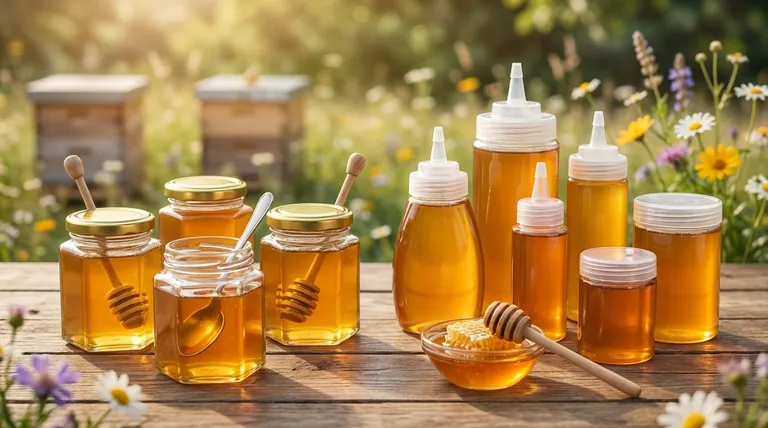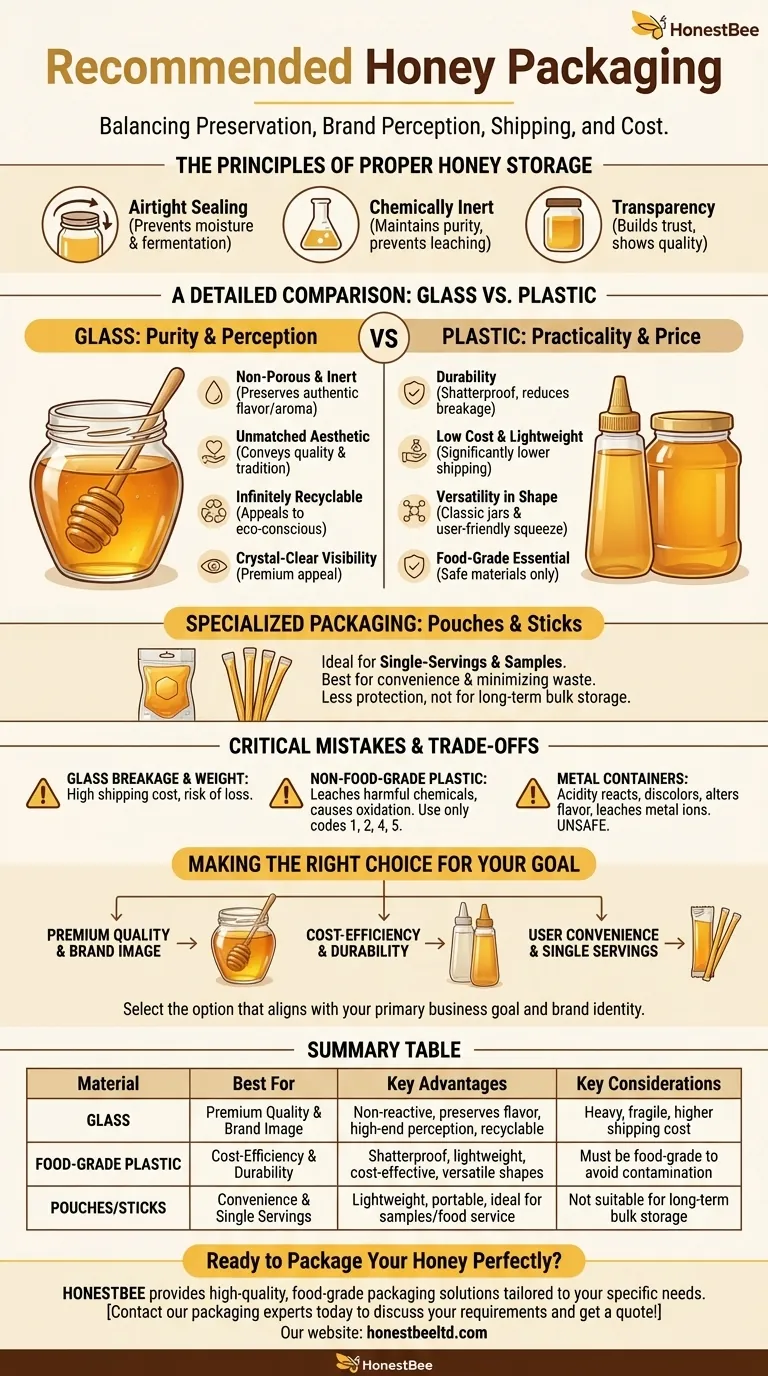In short, the recommended containers for packaging honey are food-grade plastic and glass. The ideal choice depends on your priorities, balancing factors like product preservation, brand perception, shipping durability, and overall cost. Both materials offer excellent options when sealed properly to protect the honey from air and moisture.
The decision between honey containers is not about finding a single "best" option, but about making a strategic choice. You must align your packaging with your specific business goals, whether that means emphasizing premium quality with glass or prioritizing practicality and cost with plastic.

The Principles of Proper Honey Storage
Before comparing materials, it's crucial to understand what any honey container must accomplish. Honey is a natural product that can degrade if not stored correctly, so the container's primary job is preservation.
Airtight Sealing is Non-Negotiable
Honey is hygroscopic, meaning it readily absorbs moisture from the air. Excess moisture can raise its water content above the safe threshold of about 18%, leading to fermentation and spoilage. A container with a tight-fitting, airtight lid is essential to prevent this.
The Material Must Be Chemically Inert
Honey is naturally acidic. If the container material reacts with this acidity, it can alter the honey's flavor and color or even leach unwanted chemicals into the product. The container must be non-reactive to maintain the honey's purity.
Transparency Builds Trust
Consumers value being able to see the color and clarity of the honey they are buying. A transparent container serves as a window to the product's quality, directly influencing purchasing decisions.
A Detailed Comparison: Glass vs. Plastic
The two dominant materials for honey packaging are glass and plastic. Each offers a distinct set of advantages tailored to different market positions and logistical needs.
The Case for Glass: Purity and Perception
Glass is often considered the premium choice for honey packaging. Its completely non-porous and inert nature means there is zero risk of chemical interaction, perfectly preserving the honey's authentic flavor and aroma.
This material also provides an unmatched aesthetic, conveying a sense of quality and tradition. Because glass is infinitely recyclable and offers crystal-clear visibility, it strongly appeals to environmentally-conscious consumers and those who prioritize product purity above all else.
The Case for Plastic: Practicality and Price
Food-grade plastic containers are valued for their durability and low cost. They are significantly lighter than glass and are virtually shatterproof, which dramatically reduces shipping costs and losses from breakage.
This versatility extends to shape and function. Plastic allows for classic jars as well as user-friendly squeeze bottles, which are popular for their convenience. When made from the correct food-safe materials, plastic provides an excellent, cost-effective packaging solution.
Specialized Packaging: Pouches and Sticks
For specific use cases, flexible packaging like pouches, tubes, or "honey sticks" is a viable option. These are ideal for single-serving portions, product samples, or on-the-go applications common in the food service industry.
While they excel at convenience and minimizing waste for small amounts, they offer less protection and are not suitable for long-term storage of bulk honey.
Understanding the Trade-offs and Critical Mistakes
Choosing a container requires acknowledging its downsides. Missteps here can compromise your product and brand reputation.
The Breakage and Weight Risk of Glass
The primary drawback of glass is its fragility and weight. It is more expensive to ship than plastic and carries the inherent risk of breaking during transport or handling, which can lead to product loss.
The Critical Importance of 'Food-Grade' Plastic
Not all plastic is suitable for honey. You must only use food-grade plastic (often indicated by recycling codes 1, 2, 4, or 5). Using non-food-grade plastic can lead to the leaching of harmful chemicals into the honey and can cause oxidation that ruins the product.
Why Metal Containers Are Unsuitable
You should never store honey in most metal containers. The honey's natural acidity will react with the metal, causing oxidation. This reaction can discolor the honey, alter its flavor, and potentially leach metal ions into the product, rendering it unsafe.
Making the Right Choice for Your Goal
Your container choice sends a direct message about your product. Use your primary business goal as your guide to select the best option.
- If your primary focus is premium quality and brand image: Choose glass jars to highlight the honey's purity and create a high-end feel.
- If your primary focus is cost-efficiency and shipping durability: Choose food-grade plastic jars or squeeze bottles to minimize transport costs and prevent breakage.
- If your primary focus is user convenience or single servings: Use specialized plastic pouches or sticks for on-the-go consumption and food service applications.
Ultimately, the right container is one that safely preserves your honey while perfectly reflecting the value and identity of your brand.
Summary Table:
| Material | Best For | Key Advantages | Key Considerations |
|---|---|---|---|
| Glass | Premium Quality & Brand Image | Non-reactive, preserves flavor, high-end perception, recyclable | Heavy, fragile, higher shipping cost |
| Food-Grade Plastic | Cost-Efficiency & Durability | Shatterproof, lightweight, cost-effective, versatile shapes | Must be food-grade to avoid contamination |
| Pouches/Sticks | Convenience & Single Servings | Lightweight, portable, ideal for samples/food service | Not suitable for long-term bulk storage |
Ready to Package Your Honey Perfectly?
The right container is critical for protecting your honey and building your brand. As a trusted supplier to commercial apiaries and distributors, HONESTBEE provides high-quality, food-grade packaging solutions tailored to your specific needs—whether you prioritize the premium appeal of glass or the practical durability of plastic.
Let us help you make the best choice for your operation. Contact our packaging experts today to discuss your requirements and get a quote!
Visual Guide

Related Products
- Hexagonal Glass Honey Jars with Metal Lug Caps Elegant Versatile Packaging
- Inverted Squeezable Honey Jar with No Drip Flip Top Cap for Easy Pouring
- Premium Diamond-Faceted Glass Honey Dispenser
- Plastic Hand Crank 2 Frame Honey Extractor Low Price
- Professional Plastic Queen Excluder for Modern Beekeeping
People Also Ask
- How many jars of honey do you get from a hive? Unlock Sustainable Harvesting Secrets
- How should honey be stored and packaged? Preserve Flavor & Quality with Proper Containers
- What makes raw honey more aesthetically appealing than processed honey? Discover the Beauty of Authenticity
- What is done with the honey after extraction and filtering? From Purification to Perfect Packaging
- What is the term for honey can absorb moisture from the air? Understanding Hygroscopy



















